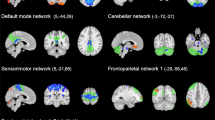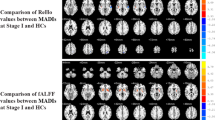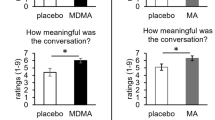Abstract
The serotonergic neurotoxin, 3,4-methylenedioxymethamphetamine (MDMA/Ecstasy), is a highly popular recreational drug. Human recreational MDMA users have neurocognitive and neuropsychiatric impairments, and human neuroimaging data are consistent with animal reports of serotonin neurotoxicity. However, functional neuroimaging studies have not found consistent effects of MDMA on brain neurophysiology in human users. Several lines of evidence suggest that studying MDMA effects in visual system might reveal the general cortical and subcortical neurophysiological consequences of MDMA use. We used 3 T functional magnetic resonance imaging during visual stimulation to compare visual system lateral geniculate nucleus (LGN) and Brodmann Area (BA) 17 and BA 18 activation in 20 long abstinent (479.95±580.65 days) MDMA users and 20 non-MDMA user controls. Lifetime quantity of MDMA use was strongly positively correlated with blood oxygenation level-dependent (BOLD) signal intensity in bilateral LGN (rs=0.59; p=0.007), BA 17 (rs=0.50; p=0.027), and BA 18 (rs=0.48; p=0.031), and with the spatial extent of activation in BA 17 (rs=0.059; p=0.007) and BA 18 (rs=0.55; p=0.013). There were no between-group differences in brain activation in any region, but the heaviest MDMA users showed a significantly greater spatial extent of activation than controls in BA 17 (p=0.031) and BA 18 (p=0.049). These results suggest that human recreational MDMA use may be associated with a long-lasting increase in cortical excitability, possibly through loss of serotonin input to cortical and subcortical regions. When considered in the context of previous results, cortical hyper-excitability may be a biomarker for MDMA-induced serotonin neurotoxicity.
Similar content being viewed by others
Log in or create a free account to read this content
Gain free access to this article, as well as selected content from this journal and more on nature.com
or
References
Bagdy G, Kecskemeti V, Riba P, Jakus R (2007). Serotonin and epilepsy. J Neurochem 100: 857–873.
Ball KT, Wellman CL, Fortenberry E, Rebec GV (2009). Sensitizing regimens of (+/−)3, 4-methylenedioxymethamphetamine (ecstasy) elicit enduring and differential structural alterations in the brain motive circuit of the rat. Neuroscience 160: 264–274.
Bankson MG, Cunningham KA (2001). 3,4-Methylenedioxymethamphetamine (MDMA) as a unique model of serotonin receptor function and serotonin-dopamine interactions. J Pharmacol Exp Ther 297: 846–852.
Baumann MH, Wang X, Rothman RB (2007). 3,4-Methylenedioxymethamphetamine (MDMA) neurotoxicity in rats: a reappraisal of past and present findings. Psychopharmacology (Berl) 189: 407–424.
Bennett MR, Farnell L, Gibson WG (2008). Origins of the BOLD changes due to synaptic activity at astrocytes abutting arteriolar smooth muscle. J Theor Biol 252: 123–130.
Birn RM, Cox RW, Bandettini PA (2002). Detection vs estimation in event-related fMRI: choosing the optimal stimulus timing. NeuroImage 15: 252–264.
Brown J, Edwards M, McKone E, Ward J (2007). A long-term ecstasy-related change in visual perception. Psychopharmacology (Berl) 193: 437–446.
Capela JP, Carmo H, Remiao F, Bastos ML, Meisel A, Carvalho F (2009). Molecular and cellular mechanisms of ecstasy-induced neurotoxicity: an overview. Mol Neurobiol 39: 210–271.
Chang L, Grob CS, Ernst T, Itti L, Mishkin FS, Jose-Melchor R et al (2000). Effect of ecstasy [3,4-methylenedioxymethamphetamine (MDMA)] on cerebral blood flow: a co-registered SPECT and MRI study. Psychiatry Res 98: 15–28.
Cowan RL (2007). Neuroimaging research in human MDMA users: a review. Psychopharmacology 189: 539–556.
Cowan RL, Bolo NR, Dietrich M, Haga E, Lukas SE, Renshaw PF (2007). Occipital cortical proton MRS at 4 Tesla in human moderate MDMA polydrug users. Psychiatry Res 155: 179–188.
Cowan RL, Frederick BB, Rainey M, Levin JM, Maas LC, Bang J et al (2000). Sex differences in response to red and blue light in human primary visual cortex: a BOLD fMRI study. Psychiatry Res 100: 129–138.
Cowan RL, Haga E, de Frederick BB, Dietrich MS, Vimal RL, Lukas SE et al (2006). MDMA use is associated with increased spatial BOLD fMRI visual cortex activation in human MDMA users. Pharmacol Biochem Behav 84: 219–228.
Cowan RL, Lyoo IK, Sung SM, Ahn KH, Kim MJ, Hwang J et al (2003). Reduced cortical gray matter density in human MDMA (Ecstasy) users: a voxel-based morphometry study. Drug Alcohol Depend 72: 225–235.
Cowan RL, Roberts DM, Joers JM (2008a). Neuroimaging in human MDMA (Ecstasy) users. Ann NY Acad Sci 1139: 291–298.
Cowan RL, Wilson CJ (1994). Spontaneous firing patterns and axonal projections of single corticostriatal neurons in the rat medial agranular cortex. J Neurophysiol 71: 17–32.
Cowan RL, Wood J, Dietrich MS, de Frederick BB, Lukas SE, Renshaw PF (2008b). Differential effects of D-amphetamine on red and blue light-induced photic activation: a novel BOLD fMRI assay of human dopamine function. Synapse 62: 268–272.
Croft RJ, Klugman A, Baldeweg T, Gruzelier JH (2001). Electrophysiological evidence of serotonergic impairment in long-term MDMA (‘ecstasy’) users. Am J Psychiatry 158: 1687–1692.
Daumann J, Fimm B, Willmes K, Thron A, Gouzoulis-Mayfrank E (2003). Cerebral activation in abstinent ecstasy (MDMA) users during a working memory task: a functional magnetic resonance imaging (fMRI) study. Brain Res Cogn Brain Res 16: 479–487.
Daumann J, Fischermann T, Heekeren K, Henke K, Thron A, Gouzoulis-Mayfrank E (2005). Memory-related hippocampal dysfunction in poly-drug ecstasy (3,4-methylenedioxymethamphetamine) users. Psychopharmacology (Berl) 180: 607–611.
Daumann Jr J, Fischermann T, Heekeren K, Thron A, Gouzoulis-Mayfrank E (2004). Neural mechanisms of working memory in ecstasy (MDMA) users who continue or discontinue ecstasy and amphetamine use: evidence from an 18-month longitudinal functional magnetic resonance imaging study. Biol Psychiatry 56: 349–355.
Ekstrom A (2010). How and when the fMRI BOLD signal relates to underlying neural activity: the danger in dissociation. Brain Res Rev 62: 233–244.
EMCDDA (European Monitoring Center for Drugs and Addiction) (2010).
Fals-Stewart W, O’Farrell TJ, Freitas TT, McFarlin SK, Rutigliano P (2000). The timeline followback reports of psychoactive substance use by drug-abusing patients: psychometric properties. J Consult Clin Psychol 68: 134–144.
Fantegrossi WE, Woolverton WL, Kilbourn M, Sherman P, Yuan J, Hatzidimitriou G et al (2004). Behavioral and neurochemical consequences of long-term intravenous self-administration of MDMA and its enantiomers by rhesus monkeys. Neuropsychopharmacology 29: 1270–1281.
First MB, Spitzer RL, Gibbon M, Williams JBW (1997). Structured Clinical Interview for DSM-IV Axis I Disorders (SCID-I), Clinician Version, American Psychiatric Press: Washington, DC.
Fischer C, Hatzidimitriou G, Wlos J, Katz J, Ricaurte G (1995). Reorganization of ascending 5-HT axon projections in animals previously exposed to the recreational drug (+/−)3,4-methylenedioxymethamphetamine (MDMA, ‘ecstasy’). J Neurosci 15: 5476–5485.
Giorgi FS, Pizzanelli C, Ferrucci M, Lazzeri G, Faetti M, Giusiani M et al (2005). Previous exposure to (+/−)3,4-methylenedioxymethamphetamine produces long-lasting alteration in limbic brain excitability measured by electroencephalogram spectrum analysis, brain metabolism and seizure susceptibility. Neuroscience 136: 43–53.
Green AR, Mechan AO, Elliott JM, O’Shea E, Colado MI (2003). The pharmacology and clinical pharmacology of 3,4-methylenedioxymethamphetamine (MDMA, ‘ecstasy’). Pharmacol Rev 55: 463–508.
Hatzidimitriou G, McCann UD, Ricaurte GA (1999). Altered serotonin innervation patterns in the forebrain of monkeys treated with (+/−)3,4-methylenedioxymethamphetamine seven years previously: factors influencing abnormal recovery. J Neurosci 19: 5096–5107.
Higgs MH, Slee SJ, Spain WJ (2006). Diversity of gain modulation by noise in neocortical neurons: regulation by the slow afterhyperpolarization conductance. J Neurosci 26: 8787–8799.
Hoffman WF, Schwartz DL, Huckans MS, McFarland BH, Meiri G, Stevens AA et al (2008). Cortical activation during delay discounting in abstinent methamphetamine dependent individuals. Psychopharmacology (Berl) 201: 183–193.
Jacobsen LK, Mencl WE, Pugh KR, Skudlarski P, Krystal JH (2004). Preliminary evidence of hippocampal dysfunction in adolescent MDMA (‘ecstasy’) users: possible relationship to neurotoxic effects. Psychopharmacology (Berl) 173: 383–390.
Jacobson MW, Delis DC, Bondi MW, Salmon DP (2005). Asymmetry in auditory and spatial attention span in normal elderly genetically at risk for Alzheimer's disease. J Clin Exp Neuropsychol 27: 240–253.
Jager G, de Win MM, van der Tweel I, Schilt T, Kahn RS, van den BW et al (2008a). Assessment of cognitive brain function in ecstasy users and contributions of other drugs of abuse: results from an FMRI study. Neuropsychopharmacology 33: 247–258.
Jager G, de Win MM, van der Tweel I, Schilt T, Kahn RS, van den BW et al (2008b). Assessment of cognitive brain function in ecstasy users and contributions of other drugs of abuse: results from an FMRI study. Neuropsychopharmacology 33: 247–258.
Kalechstein AD, De La GR, Mahoney III JJ, Fantegrossi WE, Newton TF (2007). MDMA use and neurocognition: a meta-analytic review. Psychopharmacology (Berl) 189: 531–537.
Karageorgiou J, Dietrich MS, Charboneau EJ, Woodward ND, Blackford JU, Salomon RM et al (2009). Prior MDMA (Ecstasy) use is associated with increased basal ganglia-thalamocortical circuit activation during motor task performance in humans: an fMRI study. NeuroImage 46: 817–826.
Karlsen SN, Spigset O, Slordal L (2008). The dark side of ecstasy: neuropsychiatric symptoms after exposure to 3,4-methylenedioxymethamphetamine. Basic Clin Pharmacol Toxicol 102: 15–24.
Kish SJ, Lerch J, Furukawa Y, Tong J, McCluskey T, Wilkins D et al (2010). Decreased cerebral cortical serotonin transporter binding in ecstasy users: a positron emission tomography/[(11)C]DASB and structural brain imaging study. Brain 133: 1779–1797.
Ku SP, Gretton A, Macke J, Logothetis NK (2008). Comparison of pattern recognition methods in classifying high-resolution BOLD signals obtained at high magnetic field in monkeys. Magn Reson Imaging 26: 1007–1014.
Liester MB, Grob CS, Bravo GL, Walsh RN (1992). Phenomenology and sequelae of 3,4-methylenedioxymethamphetamine use. J Nerv Ment Dis 180: 345–352.
Logothetis NK (2008). What we can do and what we cannot do with fMRI. Nature 453: 869–878.
Lyles J, Cadet JL (2003). Methylenedioxymethamphetamine (MDMA, Ecstasy) neurotoxicity: cellular and molecular mechanisms. Brain Res Brain Res Rev 42: 155–168.
Maldjian JA, Laurienti PJ, Kraft RA, Burdette JH (2003). An automated method for neuroanatomic and cytoarchitectonic atlas-based interrogation of fMRI data sets. NeuroImage 19: 1233–1239.
McCann UD, Ricaurte GA (2007). Effects of (+/−)3,4-methylenedioxymethamphetamine (MDMA) on sleep and circadian rhythms. Scientific World J 7: 231–238.
McCann UD, Sgambati FP, Schwartz AR, Ricaurte GA (2009a). Sleep apnea in young abstinent recreational MDMA (‘ecstasy’) consumers. Neurology 73: 2011–2017.
McCann UD, Szabo Z, Scheffel U, Dannals RF, Ricaurte GA (1998). Positron emission tomographic evidence of toxic effect of MDMA (‘Ecstasy’) on brain serotonin neurons in human beings. Lancet 352: 1433–1437.
McCann UD, Szabo Z, Seckin E, Rosenblatt P, Mathews WB, Ravert HT et al (2005). Quantitative PET studies of the serotonin transporter in MDMA users and controls using [11C]McN5652 and [11C]DASB. Neuropsychopharmacology 30: 1741–1750.
McCann UD, Szabo Z, Vranesic M, Palermo M, Mathews WB, Ravert HT et al (2008). Positron emission tomographic studies of brain dopamine and serotonin transporters in abstinent (+/−)3,4-methylenedioxymethamphetamine (‘ecstasy’) users: relationship to cognitive performance. Psychopharmacology (Berl) 200: 439–450.
McCann UD, Wilson MJ, Sgambati FP, Ricaurte GA (2009b). Sleep deprivation differentially impairs cognitive performance in abstinent methylenedioxymethamphetamine (‘Ecstasy’) users. J Neurosci 29: 14050–14056.
Miranda M, Bosch-Morell F, Johnsen-Soriano S, Barcia J, Almansa I, Asensio S et al (2007). Oxidative stress in rat retina and hippocampus after chronic MDMA (‘ecstasy’) administration. Neurochem Res 32: 1156–1162.
Moeller FG, Steinberg JL, Dougherty DM, Narayana PA, Kramer LA, Renshaw PF (2004). Functional MRI study of working memory in MDMA users. Psychopharmacology (Berl) 177: 185–194.
Monterosso JR, Ainslie G, Xu J, Cordova X, Domier CP, London ED (2007). Frontoparietal cortical activity of methamphetamine-dependent and comparison subjects performing a delay discounting task. Hum Brain Mapp 28: 383–393.
Moreau AW, Amar M, Le RN, Morel N, Fossier P (2010). Serotoninergic fine-tuning of the excitation-inhibition balance in rat visual cortical networks. Cereb Cortex 20: 456–467.
NIH (2008a). NCT00353938: Study of 3,4-methylenedioxymethamphetamine-assisted psychotherapy in people with posttraumatic stress disorder. Available at: http://www.clinicaltrials.gov.
NIH (2008b). NCT00402298: randomized placebo-controlled study of MDMA-assisted psychotherapy in people with PTSD—Israel. Available at: http://www.clinicaltrials.gov.
NSDUH (National Survey on Drug Use and Health) (2009). US Substance Abuse and Mental Health Services Administration.
Oliveri M, Calvo G (2003). Increased visual cortical excitability in ecstasy users: a transcranial magnetic stimulation study. J Neurol Neurosurg Psychiatry 74: 1136–1138.
Payer DE, Lieberman MD, Monterosso JR, Xu J, Fong TW, London ED (2008). Differences in cortical activity between methamphetamine-dependent and healthy individuals performing a facial affect matching task. Drug Alcohol Depend 93: 93–102.
Peat MA, Warren PF, Gibb JW (1983). Effects of a single dose of methamphetamine and iprindole on the serotonergic and dopaminergic system of the rat brain. J Pharmacol Exp Ther 225: 126–131.
Quinton MS, Yamamoto BK (2006). Causes and consequences of methamphetamine and MDMA toxicity. AAPS J 8: E337–E347.
Raj V, Liang H, Woodward N, Bauernfeind A, Lee J, Dietrich M et al (2009). MDMA (ecstasy) use is associated with reduced BOLD signal change during semantic recognition in abstinent human polydrug users: a preliminary fMRI study. J Psychopharmacol 24: 197–201.
Rauch A, Rainer G, Logothetis NK (2008). The effect of a serotonin-induced dissociation between spiking and perisynaptic activity on BOLD functional MRI. Proc Natl Acad Sci USA 105: 6759–6764.
Reneman L, Endert E, de Bruin K, Lavalaye J, Feenstra MG, de Wolff FA et al (2002). The acute and chronic effects of MDMA (‘ecstasy’) on cortical 5-HT2A receptors in rat and human brain. Neuropsychopharmacology 26: 387–396.
Ricaurte GA, Finnegan KT, Irwin I, Langston JW (1990). Aminergic metabolites in cerebrospinal fluid of humans previously exposed to MDMA: preliminary observations. Ann NY Acad Sci 600: 699–708.
Roberts GM, Nestor L, Garavan H (2009). Learning and memory deficits in ecstasy users and their neural correlates during a face-learning task. Brain Res 1292: 71–81.
Schmued LC (2003). Demonstration and localization of neuronal degeneration in the rat forebrain following a single exposure to MDMA. Brain Res 974: 127–133.
Seeburg DP, Liu X, Chen C (2004). Frequency-dependent modulation of retinogeniculate transmission by serotonin. J Neurosci 24: 10950–10962.
Semple DM, Ebmeier KP, Glabus MF, O’Carroll RE, Johnstone EC (1999). Reduced in vivo binding to the serotonin transporter in the cerebral cortex of MDMA (‘ecstasy’) users. Br J Psychiatry 175: 63–69.
Sheehan DV, Lecrubier Y, Sheehan KH, Amorim P, Janavs J, Weiller E et al (1998). The Mini-International Neuropsychiatric Interview (MINI): the development and validation of a structured diagnostic psychiatric interview for DSM-IV and ICD-10. J Clin Psychiatry 59 (Suppl 20): 22–33.
Taffe MA, Davis SA, Yuan J, Schroeder R, Hatzidimitriou G, Parsons LH et al (2002). Cognitive performance of MDMA-treated rhesus monkeys: sensitivity to serotonergic challenge. Neuropsychopharmacology 27: 993–1005.
Taffe MA, Huitron-Resendiz S, Schroeder R, Parsons LH, Henriksen SJ, Gold LH (2003). MDMA exposure alters cognitive and electrophysiological sensitivity to rapid tryptophan depletion in rhesus monkeys. Pharmacol Biochem Behav 76: 141–152.
Taffe MA, Weed MR, Davis S, Huitron-Resendiz S, Schroeder R, Parsons LH et al (2001). Functional consequences of repeated (+/−)3,4-methylenedioxymethamphetamine (MDMA) treatment in rhesus monkeys. Neuropsychopharmacology 24: 230–239.
Tork I (1990). Anatomy of the serotonergic system. Ann NY Acad Sci 600: 9–34.
Tzourio-Mazoyer N, Landeau B, Papathanassiou D, Crivello F, Etard O, Delcroix N et al (2002). Automated anatomical labeling of activations in SPM using a macroscopic anatomical parcellation of the MNI MRI single-subject brain. NeuroImage 15: 273–289.
Vannini P, Almkvist O, Dierks T, Lehmann C, Wahlund LO (2007). Reduced neuronal efficacy in progressive mild cognitive impairment: a prospective fMRI study on visuospatial processing. Psychiatry Res 156: 43–57.
Wang X, Baumann MH, Dersch CM, Rothman RB (2007). Restoration of 3,4-methylenedioxymethamphetamine-induced 5-HT depletion by the administration of L-5-hydroxytryptophan. Neuroscience 148: 212–220.
Waterhouse BD, Azizi SA, Burne RA, Woodward DJ (1990). Modulation of rat cortical area 17 neuronal responses to moving visual stimuli during norepinephrine and serotonin microiontophoresis. Brain Res 514: 276–292.
Wilson MA, Ricaurte GA, Molliver ME (1989). Distinct morphologic classes of serotonergic axons in primates exhibit differential vulnerability to the psychotropic drug 3,4-methylenedioxymethamphetamine. Neuroscience 28: 121–137.
Wish ED, Fitzelle DB, O’Grady KE, Hsu MH, Arria AM (2006). Evidence for significant polydrug use among ecstasy-using college students. J Am Coll Health 55: 99–104.
Woolverton WL, Ricaurte GA, Forno LS, Seiden LS (1989). Long-term effects of chronic methamphetamine administration in rhesus monkeys. Brain Res 486: 73–78.
Yamamoto BK, Moszczynska A, Gudelsky GA (2010). Amphetamine toxicities: classical and emerging mechanisms. Ann NY Acad Sci 1187: 101–121.
Yoshida M, Sasa M, Takaori S (1984). Serotonin-mediated inhibition from dorsal raphe nucleus of neurons in dorsal lateral geniculate and thalamic reticular nuclei. Brain Res 290: 95–105.
Acknowledgements
This work was supported by NSF (IGERT DGE-0801634 to ALB), NIDA/NIH (R01 DA01537 and R21 DA020149 to RLC, and T32DA021123 to EJC), NIMH/NIH (K01 MH083052 to JUB), and NCRR/NIH (Vanderbilt CTSA Grant UL1 RR024975).
Author information
Authors and Affiliations
Corresponding author
Ethics declarations
Competing interests
ALB, JUB, EJC JGL, CJC, NDW, AC, TW, CR D I, CC, and RMS report no potential conflicts of interest related to this report. MSD performed consultation or received compensation from the American Economic Association, Belmont University College of Health Sciences, and the University of Oklahoma Health Sciences Center. RLC received publication royalties from Lippincott Williams and Wilkins and consultant income from the Southwest Michigan First Life Science Fund, the University of West Alabama, Novo Nordisk, and Shire Pharmaceuticals.
Additional information
Supplementary Information accompanies the paper on the Neuropsychopharmacology website
Supplementary information
Rights and permissions
About this article
Cite this article
Bauernfeind, A., Dietrich, M., Blackford, J. et al. Human Ecstasy Use is Associated with Increased Cortical Excitability: An fMRI Study. Neuropsychopharmacol 36, 1127–1141 (2011). https://doi.org/10.1038/npp.2010.244
Received:
Revised:
Accepted:
Published:
Issue date:
DOI: https://doi.org/10.1038/npp.2010.244
Keywords
This article is cited by
-
Thalamocortical connectivity is associated with autism symptoms in high-functioning adults with autism and typically developing adults
Translational Psychiatry (2021)
-
Intrainsular connectivity and somatosensory responsiveness in young children with ASD
Molecular Autism (2017)
-
Brain Serotonin Function in MDMA (Ecstasy) Users: Evidence for Persisting Neurotoxicity
Neuropsychopharmacology (2013)
-
Human ecstasy (MDMA) polydrug users have altered brain activation during semantic processing
Psychopharmacology (2013)
-
Methodological Weaknesses in Non-Randomized Studies of Ecstasy (MDMA) Use: A Cautionary Note to Readers and Reviewers
Neuropsychopharmacology (2012)



